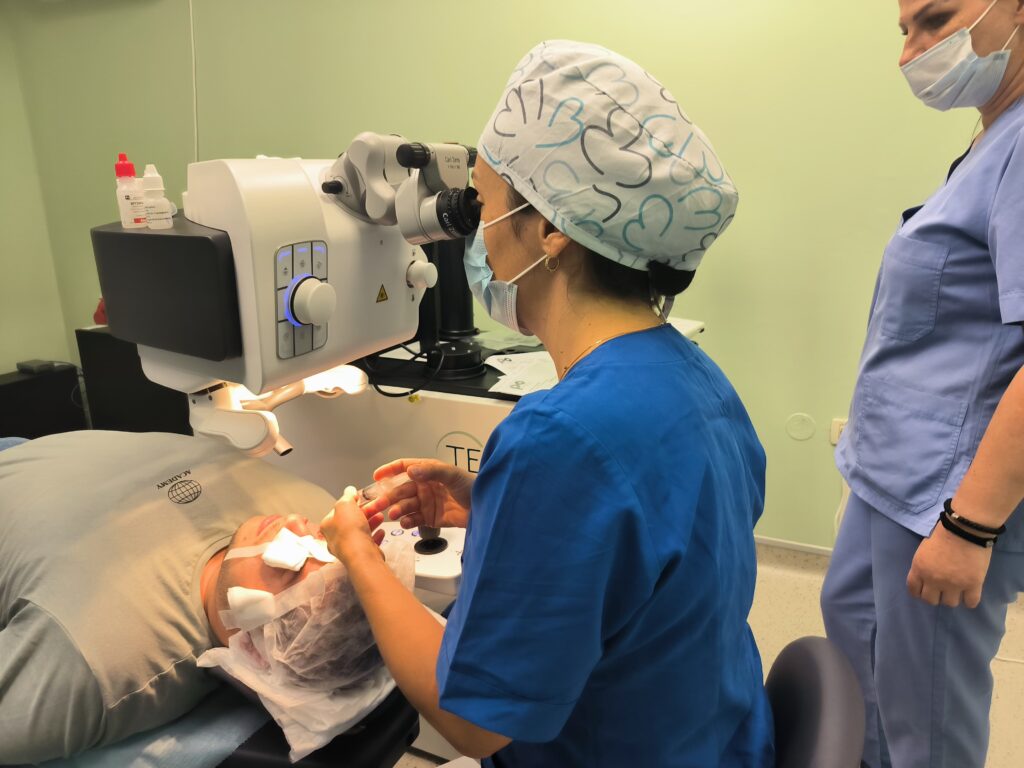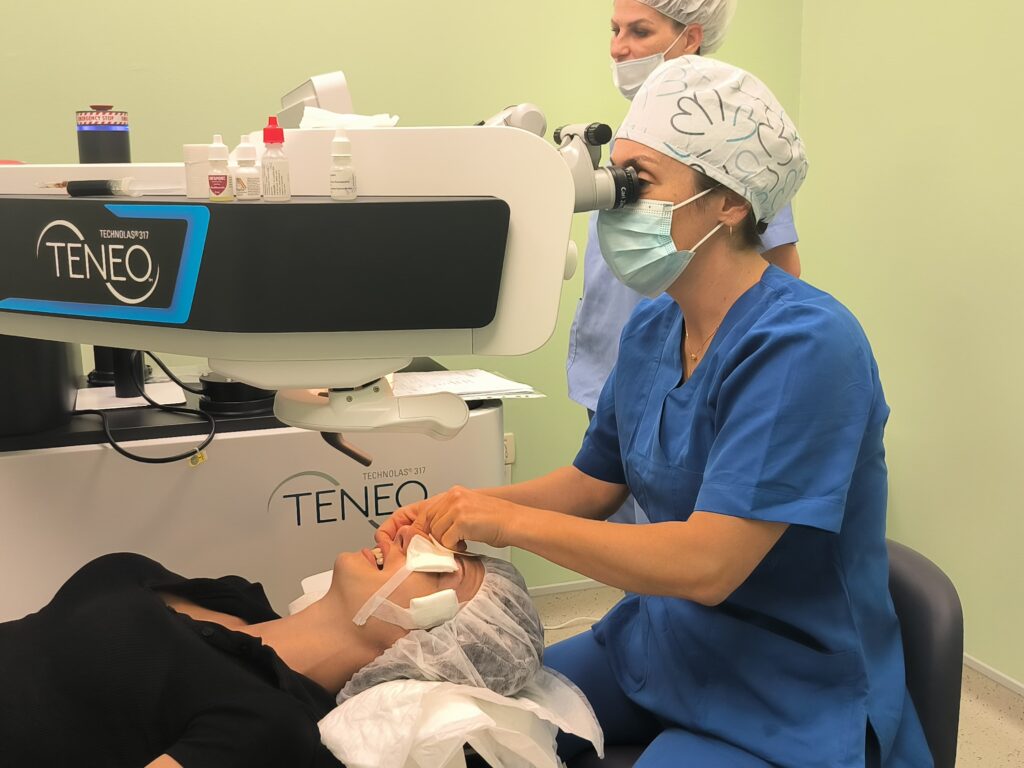LEARN MORE ABOUT THE LASER INTERVENTION CENTER
The Laser Intervention Center uses state-of-the-art laser technologies for the correction of refractive errors and the treatment of refractive anomalies. With innovative and painless methods, the center provides a fast and reliable recovery with maximum precision and comfort for patients.
Excimer laser – NO TOUCH (trans PRK) TECHNOLAS TENEO 317
• Painless
• Fast
• Safe
• Non-contact
• No side effects
• No corneal incision
• No grinding of the cornea with brushes
It is about the most modern technology and revolutionary laser approach. NO TOUCH (trans PRK) TECHNOLAS TENEO 317 is an innovative technology with a WOW effect, so called because of the exclamation of delight of patients immediately after the intervention – WOW! The procedure does not require the creation and formation of a flap, it allows maximum precision with the fast eye tracker for detection of even the finest eye movements and control of static and dynamic cyclotorsion, ensuring perfectly precise centering at every moment.
The high speed of the laser beam, which patients describe as “fireworks”, significantly shortens the time of the laser procedure and provides rapid vision recovery immediately, without pain, with a perfectly smooth and transparent surface of the cornea and with preserved quality.
This atraumatic procedure, without flap formation, without a knife, practically TOUCH FREE, is an effective, safe method for laser correction of diopters that has been worked on for years.
This procedure provides a greater advantage over the LASIK method, where there is a certain risk of flap complications several months and years after the intervention, as well as increased comfort and painlessness compared to the former PRK method.
1. What is laser diopter correction?
Laser diopter correction is a procedure where the cornea is remodeled using laser beams in order to get rid of existing diopters, improving visual acuity and eliminating the need for optical aids (glasses or contact lenses).
2. What are refractive errors?
Refractive anomalies is the technical term for diopters and depends on the length of the eye (the normal length of the eye is about 24 mm).
Refractive anomalies include:
• Myopia (short-sightedness) – a consequence of the greater length of the eye, so the image is formed in front of the macula. The minus diopter is corrected in order to move the image and form it in the center of the vision, thus sharpening the vision.
• Farsightedness (HYPERMETROPIA) – a consequence of the shorter length of the eye, and the image is formed in an imaginary point due to the macula. With a plus diopter correction, the image is moved to the center of vision and sharpening of vision at near and far is obtained.
• Astigmatism – irregular curvature of the cornea in a certain meridian, resulting in a blurry image. It is corrected with cylinders that correct the irregular curvature of the cornea. It most often occurs in combination with myopia or hyperopia.
3. What conditions must be met for laser diopter correction?
The first condition is the patient’s age, older than 18 years. The eye must be healthy, therefore a complete ophthalmological examination is performed beforehand, which includes a series of analyzes and measurements. The diopter must be stable for at least the past year, because if the diopter tends to change after the laser correction itself, a new diopter will be obtained again.
If all of the above conditions are met (corneal thickness and curvature, diopter range, patient age), this is a way to safely perform laser diopter correction.


4. Which diopters can be removed with laser correction?
The diopter that can be corrected with a laser is in the range of +6 to -10 D and up to 6D astigmatism. Laser correction belongs to the group of aesthetic procedures because the goal is to get rid of optical aids, so the eye must be healthy in order to obtain satisfactory results from the intervention.
5. How is laser diopter correction performed?
This intervention is performed with the most modern laser devices that have built-in software systems for treatment and eye tracking. The eye tracking system (eyetracker) has the role of monitoring the movements of the eye during the intervention and ensuring that the laser beams act on the target part of the cornea at all times.
LASIK is the most commonly performed surgical method. It consists of two steps, where in the first step a flap (a thin flap of the cornea) is made. After shaping and lifting this flap, laser beams remodel the cornea. After the procedure is completed, the flap is returned to the surface. The procedure itself takes a short time, is painless and comfortable.
PRK is the oldest method, where the surface layer (epithelium) of the cornea is first removed with the help of laser beams, and then its surface is remodeled with the same laser beams. Compared to LASIK, PRK is less comfortable, and the healing process is somewhat longer. In modern refractive surgery, this method is used in cases of thin corneas, small irregularities and scars on the cornea.
Trans PRK (Transepithelial Photorefractive Keratectomy) is a new, “no touch, all laser” revolutionary method in refractive surgery. Patient-friendly, with faster epithelial healing as a result of the smaller, clean epithelial margin resulting in minimal period of discomfort for patients.
In NO TOUCH (trans PRK) TECHNOLAS TENEO 317 with computer application of a “cold” laser beam, the task is to remodel the cornea and change its refractive power. This is achieved by directly acting on the surface of the cornea, touch free trans PRK surface method – which, by applying new innovative technology, provides an exceptional and fantastic experience for patients with a WOW effect in visual acuity immediately after the intervention.
The procedure takes a few minutes, with a quick recovery. A great advantage over standard procedures, PRK, LASIK.
The key difference between PRK and trans PRK (NO TOUCH) is the method by which the surface layer (epithelium) of the cornea is removed. Trans PRK uses a laser, while PRK uses alcohol to remove the surface layer of the cornea and special brushes to manually abrade the epithelium.
6. What if simultaneous correction for near and far vision is needed?
Laser diopter correction is performed on people aged 18-40, as it corrects the diopter for distance. If the patient is of an age where he also has diopter for near, which is a consequence of the normal physiological process of aging of the eye and a decrease in the eye’s ability to accommodate, then INTRAOCULAR REFRACTIVE SURGERY is performed.
7. Postoperative period
The LASIK method as a surgical intervention is very comfortable for the patient. The patient looks after the surgical procedure, the eyes are open. Antibiotic drops are given and are given for a certain period of time together with artificial tears. Full visual acuity is achieved one day after the intervention itself and the patient can perform daily activities.
During the first month, it is recommended to avoid heavy physical work, contact sports, and possible infections.
The PRK method is somewhat less comfortable, but is surgically safer. After this type of surgery, discomfort may occur in the form of scratching and increased tearing. The eye is protected with a therapeutic contact lens for several days or until the surface layer of the cornea has completely regenerated. In the case of PRK, antibiotic drops and artificial tears are also prescribed. Within 5-7 days after laser correction, patients can return to daily activities, heavy physical work or contact sports.
Control examinations are performed 1 day after laser correction, after 5-7 days, and after 1 month.
NO TOUCH (trans PRK) is the absolute best method because the laser works through all phases.
8. Can the diopter be restored after laser correction?
A very important role is played by the preoperative examination and the data on stable diopters for at least one year before laser diopter correction. If these conditions are met, the diopter cannot be restored.
It is also very important that patients who have had laser vision correction develop age-related farsightedness and the need to wear glasses for near vision after the age of 40. This is a normal process of aging and weakening of accommodation, and not a return to the pre-existing vision.
1. How should you proceed before laser diopter correction?
A few days before surgery:
• Do not wear contact lenses (soft contact lenses for 7 days, semi-hard and hard lenses for 10-14 days)
Night before surgery:
• If necessary, take one diazepam 5 mg tablet.
On the day of surgery:
• It is mandatory to have breakfast before laser correction
• If the patient has regular systemic therapy, it is necessary to take it regularly
• To come with an escort
• To bring sunglasses with you
• To not put makeup on the face and neck
• If you have artificial eyelashes or earrings, you need to remove them beforehand
Before entering the operating block:
• The use of candy and chewing gum is prohibited.
• All personal items must be left in our pre-operative block.
2. How should you proceed after laser diopter correction?
On the day of the procedure
after completion of the laser correction:
• Vision will be blurred (as if you are looking through water)
• There is a feeling of discomfort and burning,
sometimes pain in the eyes
, tearing, swelling of the eyelids
• Do not touch the eyes
• Keep the eyes closed as much as possible and stay indoors
• Every hour, apply sol. Tobradex and artificial tears (1-2 drops)
• After a meal, it is necessary to take tbl. Ibuprofen 400 mg
Three post-operative check-ups are required. A mandatory check-up is the day after the laser correction,
the next check-up is in 3-7 days in agreement with the doctor, and a monthly check-up. Check-ups within a period of one month after the laser correction are free of charge, and thereafter are charged.
Recovery:
• During the next 10 days, it is necessary to apply sol. Tobradex 4×1 a artificial tears 6 to 8 times during the day for a period of one month.
• Avoid working on the computer and watching television for a long time (due to additional drying of the eyes)
• For 2 weeks, the use of makeup (mascara, eyeliner) is not allowed
• Do not visit the gym for 14 days
Sunglasses should be worn every time you go out to reduce glare and thus protect against additional eye dryness and accidental injuries.